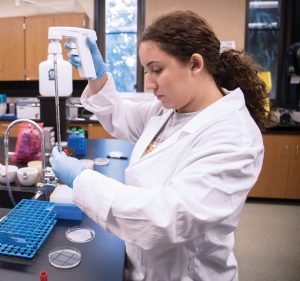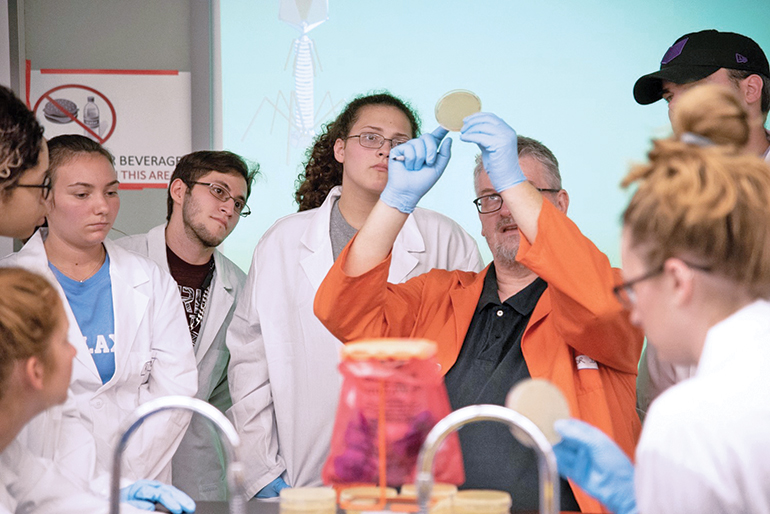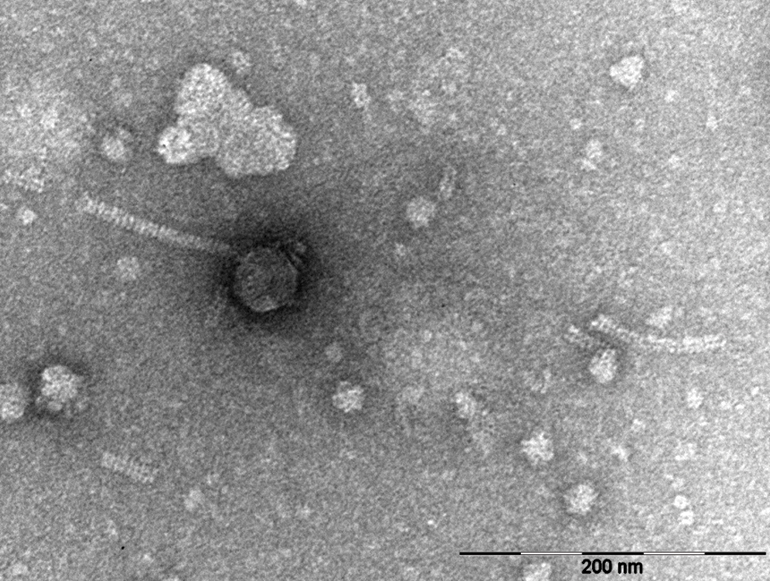
Several months ago, Kevin Szafran scooped up a soil sample from an apartment complex in Dade City, FL. Little did he know this dirt would contain a bacteriophage to be included in a global database.
Szafran, who graduated from the university in May 2022, had the opportunity to participate in the Science Education Alliance (SEA) Phages program, a project the university joined several years ago. Since 2008, the Howard Hughes Medical Institute and the University of Pittsburgh have collaborated to facilitate this bacteriophage research initiative for biology students attending more than 150 colleges and universities. Szafran, a biology major focusing on biomedical science, has been part of the two classes specific to phage discovery and analysis.
“We had to collect three environmental samples from three different locations,” Szafran said of the project. “The phage I discovered was from the soil of a flowerbed with fertilizer. I collected it the day after it had rained, so it was moist and seemed like a viable location. For me, only one out of my three samples contained a phage.”
Szafran explained the steps following the sample collection.
“We then go through rounds of amplifying, purifying, and isolating a bacteriophage, which is essentially a virus that infects a bacterial host,” he said. “We send off the sample to the University of Pittsburgh for further analysis in which they sequence the genome to determine which family of bacteriophage it belongs to.”
Phage process
Some phages can cause benign bacteria to become pathogenic (disease-producing) by transferring in pathogenic genes. Other phages use the bacteria as a host to make more viruses before killing them.
The two Saint Leo courses focused on practical research in the use of bacteriophages are BIO 100: Intro to Research – Phage Hunters and BIO 200: Phages II. In addition, a third course related to phages was introduced to biology students in the 2021-2022 academic year. In BIO 300: SEA-Genes, students clone phage genes and express their proteins, ultimately trying to assign a function to those genes.
Szafran named the phage he discovered “Upsilon” in recognition of Saint Leo’s Upsilon Theta chapter of the Kappa Sigma fraternity to which he belongs.

“Jovita” is a phage discovered by junior Gabby Fonseca. She took her sample from an area near a tree stump on the banks of Lake Jovita at University Campus. Among the other Saint Leo phages are “BlueRugrat,” found by Kaishon Showers, and “Katzastrophic” found by Emily Katz.
“It has been a rewarding experience,” Szafran said. “The work I’ve put into this and getting my name on a nationally recognized website is definitely an amazing opportunity. Publications are the epitome of research and are so instrumental in helping me pursue further education.”
Dr. Iain Duffy, an associate professor of biology in the Department of Natural and Applied Sciences, brought the courses to the university four years ago. Duffy teaches all three classes related to phage discovery and analysis.
“Only a small number of phages have been discovered, but how they function has yet to be determined in many cases,” Duffy explained. “These are not your typical college classes. This is real research being done on viruses that nobody has ever seen before. Plus, we have many freshmen and sophomores taking these courses, giving them a leg up as they advance in the program.”
Along with hands-on experiential learning, students’ names are published on a dedicated database webpage hosted on the PhagesDB website. They also may present their findings at the national SEA Symposium and the Florida Academy of Sciences’ annual conference, as well as during Saint Leo’s Academic Excellence Day.

According to Duffy, numerous Saint Leo graduates have applied their experience with this project to their careers. Several have gone on to work at H. Lee Moffitt Cancer Center in Tampa, FL. A few alumni now work in the cancer center’s cell therapy lab where they are helping to develop cancer treatments, while others have participated in the SPARK internship program at Moffitt.
“The students are becoming much more confident in their lab techniques and are using this experience in their careers,” Duffy said of completing the phage classes.
As for Szafran’s future plans, his goal is to attend medical school and become a physician, potentially specializing in cardiology.


Comments are closed.